ART
New War Pictures THE latest Official War Art at the National Gallery is the best yet. In the newly-hung room the artists concerned show signs that they are going to create something out of the war instead of merely keeping a tradition alive through it. Some of them are still only changing out of lounge-suits into khaki or R.A.F. blue, but others seem to show that their experience is changing, and that war is something more than .n interruption and an irritation. It is not camouflage nor unifprrns, nor the clean lines of a gun, nor even heroic profi:es, that make good subjects for war-pictures; it is death and destruction, and the
agony that stays about the rubbish-pile and the grave. Henry Moore's shelter drawings look as if he has been excavating in early tombs : he has dug down and found monumental beauty. His creatures are tragic and submerged, but his drawings of them are detached and far more moving than if they were stuck over with labels of sorrow and pity. Paul Nash has made what he calls a Dead Sea out a mass of broken enemy-aeroplanes. This grey amalgam heaving against a moonlit English landscape is frozen into silence and death. Graham Sutherland shows a series of pictures of devastation among City offices, factories and warehouses. If anyone still doubts the wisdom of employing artists who can make records of experience during war he should see these vivid pictures and compare them with what the camera would say about the same subjects; twisted girders pouring over fired rubble-piles; a wall falling like a shot man; the broken carcase of a lift-shaft; machinery dangling its severed limbs in the bare well of a mantle-factory.
Stanley Spencer is at work on a large decoration of which he shows here two sections : Welders and Burners. The main sub- ject is Shipbuilding on the Clyde, but from these sections it is impossible to tell much of the general effect—their shape is awkward and distracting. If we must have war portraits, Barnett Freedman's R.A. Commanding Officers and a District Gunner (nineteen of them in one frame) is a good decorative solution.
Ardizzone, Topolski and Kapp—all represented here—are the best illustrators the war has yet made use of. Ardizzone is still character-impressionist, and it is true of him that he has only changed his subjects into khaki. Topolski's first concern is always gesture, though one might call him "dramatic impres- sionist," with his big show (just closing at ICnoedler's) in mind. If good war-painting is a question of finding new happy effects of colour and form among ruined buildings, and of letting the tragedy look after itself, then two water-colours of Aberdeen and Clydebank, by James Miller, are among the best things here. They are pleasing in any case.
At the Leger Galleries, 13 Old Bond Street, there is a new exhibition of war pictures by Clifford Hall, called "Bombs on Chelsea." The artist is attached to a Chelsea stretcher-party, and his small, rather slight drawings have a good deal of interest and "actuality." They are best when least literary and most formal—as in Fire-watchers Queueing up for Food and Barrage






























 Previous page
Previous page